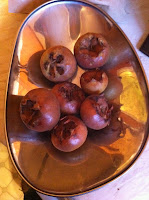They are not very attractive fruit. Apparently they were, in medieval times, known as cats arse fruit, (and in French they are cul de chien which is no better)
And, as I learned, you can't use them stright away, but have to wait until they have "bletted" - effectively this means waiting for them to start to rot.. they go darker, and much softer.

I had some reservations, but decided to press on, having aquired the things, so they have spent the last few weeks sitting in a paper bag in the shed, bletting away to themselves, and today I decided it was time to move on. The most common recipie seems to be for Medlar jelly, so that's what I decided to make, although you can eat them raw, or bake them, or make 'cheese' out of them.
They looked even less appetising when I cut them up: completely borwn inside, whereas the flesh is white (like an apple) before they are bletted, but I did taste one - a rather unplesant 'wooly' texture, but the taste was OK - a bit like spiced apple,.
 The recipie I used also included apple, and was pretty straightforward - you cut up the apple and medlars and simmer in water until they go soft, then strain them overnight before boiling up the juice with some sugar and a little lemon juice.
The recipie I used also included apple, and was pretty straightforward - you cut up the apple and medlars and simmer in water until they go soft, then strain them overnight before boiling up the juice with some sugar and a little lemon juice. I ended up wih more liquid than I'd expected (the recipie didn't specifiy, just said to use enough to cover the fruit) so I was concerned that the jelly might not set, but it does appear to be doing so.
I haven't tasted the jelly yet, but it looks pretty. Mine is a little cloudy, but I think that is purely aesthetic, and won't affect the taste. It apparently goes well with game or lamb (as one might use redcurrant jelly) but I suspect it might be rather nice on toast, too.
And on a cold, icy, day there are worse things to do than to fill the house with a warm, spiced-apple aroma!

1 comment:
It does look nice! We want a full report on the taste test.
Post a Comment